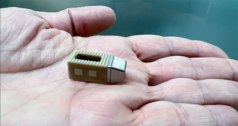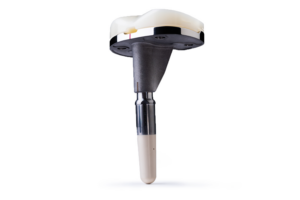
Ben Hertzog, Ph.D., CEO of Intelligent Implants, believes that orthopedics is on the brink of a data-driven era. “I say this from the perspective of a company that developed a smart implant with a therapeutic focus,” he said. “That’s what excites me the most about the technology.”
Intelligent Implants applied implantable electrical stimulation of bone directly into the design of its SmartFuse system, a PEEK and titanium cage that uses hermetically sealed electronics and an array of electrodes to accelerate bone growth in the lumbar spine.
“Instead of administering stimulation from outside the body, we developed a local delivery system through electrodes on the device, allowing us to precisely measure and control where the bone grows,” Dr. Hertzog said. “We have direct diagnostic feedback on our therapy and a way to assess its effectiveness.”
As a researcher, Dr. Hertzog appreciates the benefits of using smart implants to collect a patient’s real-time kinematic data during their recovery from surgery and correlating the information to improved outcomes. He also raises an important question that still needs to be answered in the development of smart implant technology: Who’s going to pay for the data collection and analysis?
“Do I believe that over time this data will be incredibly powerful, allowing us to gain insights and then refine implant designs and surgical procedures? Absolutely,” he said. “But asking payors to cover a more expensive, complex device now based on the promise of better outcomes in the future is a challenging proposition.”
Economical Care
Dr. Hertzog believes smart implant technology’s future lies in collecting and measuring clinical data and allowing caregivers to adjust the therapy in real time to maximize patient outcomes. “That’s where things start to get interesting,” Dr. Hertzog said. “However, there are still challenges to overcome.”
Orthopedic and spine companies must establish a clear value proposition and clinical benefit to obtain reimbursements for smart devices, Dr. Hertzog noted. “The question of how we get paid is a significant one,” he said.
To address health economics and related challenges, Intelligent Implants is focused on improving patient outcomes by enhancing spine fusion success and shortening healing times. “If we can achieve these improvements, we know how to justify reimbursement,” Dr. Hertzog said. “In this case, the cost burden of the implant’s diagnostic component becomes negligible.”
Ideally, smart implant technology can be used to identify patients who need additional attention among a larger population. “The implants would highlight the few who are at increased risk of complications or are having issues, allowing caregivers to focus their efforts where they’re most needed,” Dr. Hertzog said. “They can spend time addressing critical cases instead of managing every patient equally.”
Dr. Hertzog has sat in the waiting rooms of surgeon offices and wondered how many people were surgical candidates versus those who was there for post-op visits. “The reality is that many patients are there to be seen after surgery,” he said. “Surgeons weren’t trained to perform follow-up care. They are compensated for surgeries, which fund hospitals and are crucial to the success of their practice.”
Using the data and feedback that smart implants provide to determine which follow-up visits are unnecessary could significantly shift how surgeons manage their schedules. “Allowing them to spend more time performing surgeries and less time on appointments is a transformative prospect,” Dr. Hertzog said. “The value lies not only in clinical outcomes, but also in improving patient care delivery and reducing the cost burden of healthcare.”
When a spine fusion fails, patients are subjected to an invasive and expensive procedure. Dr. Hertzog noted that reported success rates of spinal fusion surgery are as high as 95%, but he believes a lack of comprehensive data has led to an inflated perception of the surgery’s effectiveness.
“Patients might appear to be doing well initially, but incomplete fusions can result in hardware failure more than a year after surgery,” he said. “This highlights the need for better data and more accurate measurements of fusion success.”
Dr. Hertzog also sees a significant value proposition of smart implant technology for the average patient. “If we can accelerate healing and measure bone growth and fusion accurately, we can provide more personalized and timely recommendations for resuming normal activities,” he said. “This means patients can return to their typical routines faster, which is a huge benefit. Additionally, this approach benefits surgeons by allowing them to focus on other patients once their current patients are fully healed.”
FDA requires spine companies that are developing motion preservation technology to compare the outcomes of clinical trials to the established results of spinal fusion surgery. Dr. Hertzog noted that fusion surgery outcomes data has come from small, single-site or physician-sponsored studies. Smart implant technology has the potential to improve the quality of the data that’s collected and used as a baseline result.
“We now have access to clinical data sets that provide better insights into the actual success rates of fusion procedures,” he said. “This shift is helping us better understand the challenges of achieving quality outcomes and presents an opportunity for our technology to make a significant impact on patient care.”
Reducing the Cost of Recovery
Bill Hunter, M.D., founded Canary Medical, the pioneering company that has forged a path of success in smart implant technology. Canary Medical partnered with Zimmer Biomet to develop the Persona IQ knee implant, which measures and determines range of motion, step count, walking speed and other gait metrics in patients who are recovering from joint replacement surgery. The company recently received FDA Breakthrough Device Designation for its Canturio Lumbar Cartridge for spinal fusion.
Dr. Hunter, Canary Medical’s President and CEO, believes that smart implant technology has the potential to transform the traditional healthcare delivery model. “The economic reality is that post-surgical care is dramatically more expensive than performing a procedure,” he said.
Canary Medical has analyzed more than 1.4 million reports of total knee replacement patients over the last four years and found that Medicare spends $5 billion annually on these surgeries and three times as much on patient after-care.
These hidden costs of surgery include post-op imaging, emergency room visits, readmissions, home care, physical therapy, acute revision procedures and treatment of post-op complications. “Each joint replacement is not simply a present cost,” Dr. Hunter said. “It’s an ongoing financial commitment.”
According to Dr. Hunter, bricks-and-mortar medicine — doctors, hospitals, healthcare workers, administrators and payors — is prohibitively expensive and needs to be reserved for acute care patients. “Routine follow-up care must be delivered in the home through inexpensive and, where possible, automated online systems,” he said.
Dr. Hunter pointed out that over 80% of total knee replacement patients recover unremarkably and probably don’t need post-op imaging, office follow-up or home visits. Conversely, he said, the struggling minority of patients must be identified quickly and efficiently before small problems evolve into big ones.
He believes smart implants carry inherent benefits that wearable technology can’t match. “Patients go to their surgeon because they need an implant, not an Apple Watch. Smart implants provide status reports on activity, function and potential complications with minimal compliance,” Dr. Hunter said. “Why settle for indirect measurements when direct measurements are available? As smart technology improves, it becomes inevitable — and economical. There aren’t enough healthcare professionals, facilities or dollars to deliver universal personalized care any other way.”

Canary Medical and Zimmer Biomet partnered to create Persona IQ, the device that showcased the potential of smart implant technology.
Proactive Treatments
Fred D. Cushner, M.D., a knee replacement specialist at the Hospital for Special Surgery and Founding Member and Chief Surgical Officer at Canary Medical, said the transformational power of smart implant technology is found in the use of the patient data that are collected.
“With Persona IQ, we have identified what is considered acceptable recovery for different demographics of the patient population and can identify patients who are recovering at, above or below average,” said Dr. Cushner. “This information allows clinicians to intervene earlier than previously possible to potentially change the patient’s recovery trajectory and reduce the cost of post-surgical recovery.”
According to Dr. Cushner, data collected from patients will allow orthopedic companies to develop algorithms that can provide a diagnosis for many postoperative complications, such as implant loosening and infection. “This information could also transform the surgical approach, helping surgeons perform surgery with optimal technique,” he said.
Dr. Cushner uses the data collected from Persona IQ to conduct early interventions on patients who are struggling in their recoveries. The remote monitoring of kinematic data allows him to adjust an individual patient’s treatment plan.
“Sometimes all it takes is a phone call to make a difference,” he said. “Previously, I had to wait until knee replacement patients came into the office for follow-up care to understand how they are rehabbing from surgery. That can be too late to make a significant impact on their outcomes. The movement from remote monitoring to remote diagnosis has significant potential for total knee arthroplasty patients.”
Dr. Cushner believes that the data currently being collected from patients and its ability to inform surgical planning and implant design is a significant benefit for emerging applications of smart implant technology. “The key learning has been the ability to take this very novel data and interpret it for clinical use,” he said. “Currently we can stratify patients based on their data, which is important for early interventions to treat complications or potential complications. I believe future insights will continue to revolutionize patient care.”
Artificial intelligence (AI) and large language models will analyze the data collected by smart implants to help orthopedic companies and surgeons address the 20% of total knee replacement patients who are typically unhappy with the outcome of their surgery, according to Dr. Cushner. “Identifying patients who are struggling, diagnosing post-surgical complications, providing early clinical intervention and encouraging patient compliance with post-op care regimens are keys to the technology’s continued evolution,” he said.
Taking the Next Step
Orthopedic and spine companies have traditionally focused on innovation in implant designs, surgical planning, navigation and robotic assistance. “The next big step is to embed smart technology directly into implants, allowing for real-time data collection and to control how well patients are healing,” Dr. Hertzog said. “This advancement will enhance outcomes and create new opportunities to advance how surgeries are performed and how well patients recover.”
Dr. Hertzog said that Intelligent Implants’ technology has broad application across orthopedics. “With very few exceptions, every implant requires bone growth or healing,” he explained. “If we can accelerate and control this process, and accurately measure when it’s complete, the value is immense.”
The company is exploring therapeutic implant applications in trauma, long bone repair and critical femur defects. It’s also considering how to apply the technology to arthroplasty, particularly in mature markets where there’s less technological differentiation. For example, Dr. Hertzog said embedding therapeutic technology into the stem of a cementless hip implant could help address post-op osteopenia by promoting bone growth.
“Such an implant could monitor bone quality and alert physicians to initiate additional therapy as needed,” he explained. “There are numerous possibilities to explore with this therapeutic component of smart technology.”
DC
Dan Cook is a Senior Editor at ORTHOWORLD. He develops content focused on important industry trends, top thought leaders and innovative technologies.




